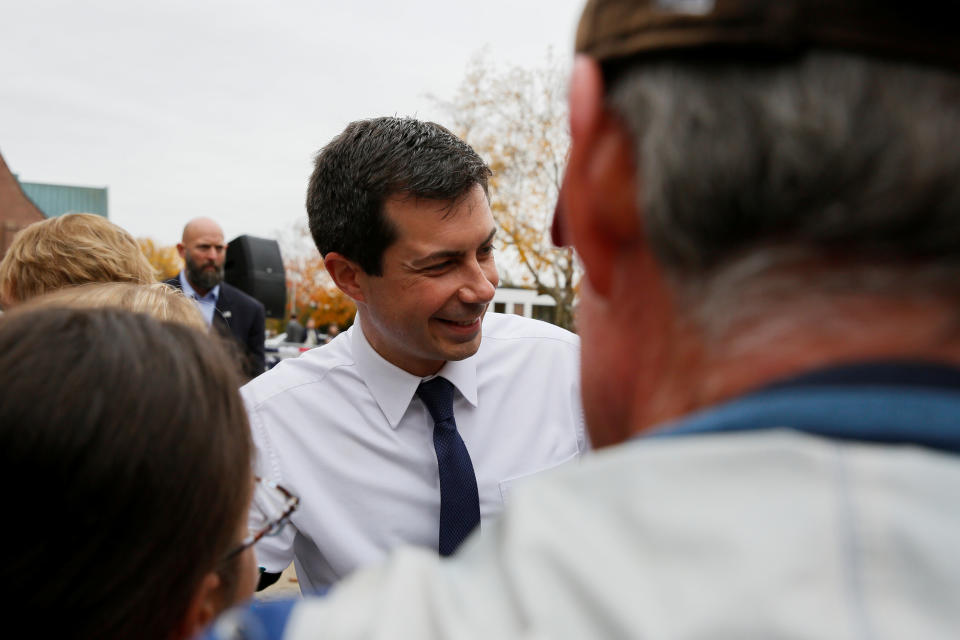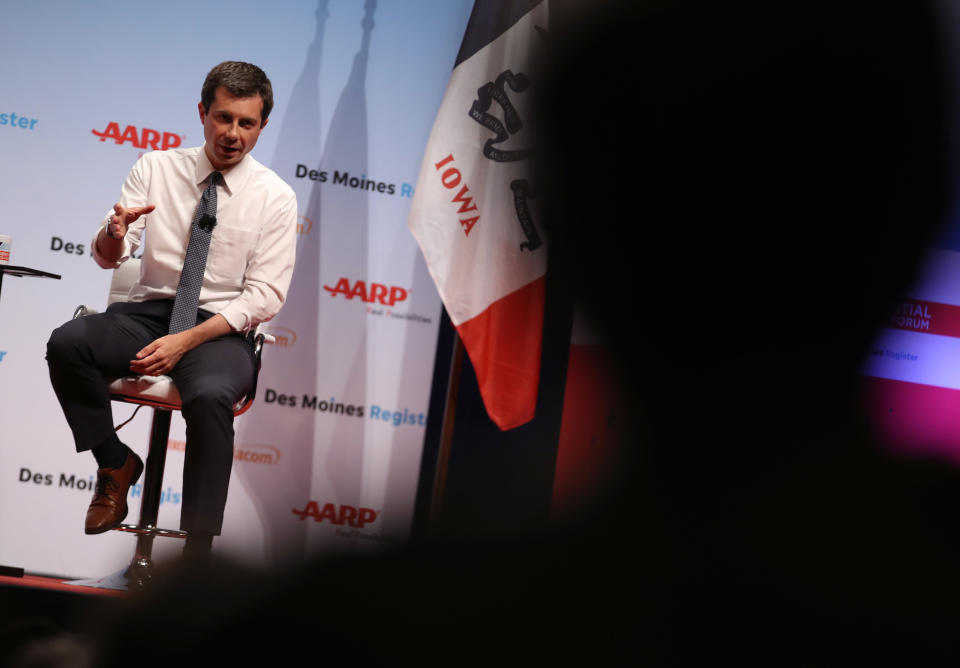Pete Buttigieg has a big new plan to shake up the retirement system
Earlier this year, Pete Buttigieg, the 37-year-old mayor of South Bend, Indiana, noted on the presidential campaign trail, “I know I’m the young guy in the race but retirement is on my mind a lot.”
On Monday, he released a plan that proved it.
The 19-page document is one of the most detailed retirement plans so far from a 2020 contender. Long-term care is at the plan’s center with the South Bend mayor proposing what amounts to a new government entitlement for certain eligible retirees. There are changes to Social Security to make the program solvent for a longer period of time and increase its benefits. And there’s a new way to privately save for retirement that puts employers on the hook to help their workers save.
The challenges facing the retirement system are daunting. They include rising health care costs, a Social Security trust fund that will be depleted in about 15 years, and the fact that only half of American workers participate in a retirement plan at work.
“I am determined to usher in a new era for older Americans that upholds the unshakable promise that every American should be able to maintain a decent standard of living when they retire,” Buttigieg said in a statement announcing the plan.

A new government entitlement for long-term care
Perhaps the most ambitious part of the plan would create a “a historic and free long-term care program to protect people over age 65” called Long-Term Care America that amounts to an addition to the social safety net.
Here’s how it works: every retiree who needs help “with two or more activities of daily living” would get $90 a day to defray the costs of long term care after some waiting periods based on income. The benefit could be used for things like hiring a home health aide or paying for a nursing home.
The current average Social Security benefit is $1,471 per month. This program, at $90 a day, would be a benefit worth almost double that for the much smaller number of eligible seniors.
The total cost of the plan is unclear. A plan summary notes that 11.3 million people who are currently over 65 will receive benefits from the program at some point in their life. Research cited by the campaign notes that among people who receive long-term care “most will need assistance for less than two years.” The costs of the program would be paid for by greater tax enforcement on the wealthy.
The plan has a range of inducements to encourage seniors to stay at home for their care. That is a feature that Nancy Altman, president of a group called Social Security Works, thinks will help defray some of the cost. "There really are incentives for people to stay at home, as opposed to, the immediate default is spend down, go on Medicaid, and go into an institution," she says adding that currently there is an "unintended bias in the current law towards institutional care.”

In-home care, even for 8 hours a day, tends to cost substantially less (and tax the health care system less) than moving full-time into an assisted living facility.
The plan also includes a variety of provisions to reshape the long-term care industry and grow the direct-care workforce. If the mayor’s new infusion of money becomes reality, the demand for direct care workers would likely skyrocket. There would also be new regulations including training for paid care workers as well as new financial help for both paid and unpaid caregivers. The plan would also implement minimum staffing ratios at long-term care facilities.
The release of Buttigieg’s plan means that three of the 2020 Democratic frontrunners have aggressive plans to help seniors with long-term care. On his website, Senator Bernie Sanders notes that Medicare for All would expand Medicare coverage to include “home- and community-based long-term care” with similar provisions in Elizabeth Warren’s plan.
The Buttigieg plan would preserve Medicare Advantage and allow seniors to choose among different private health plans if they want. Medicare for All would do away with private health insurance.
Former vice president Joe Biden has offered less detail on long-term care but notes that he will "make sure the program gives those on Medicaid who need long-term care the flexibility to choose home- and community-based care" as well as providing "tax relief to help solve the long-term care challenge."

More money for Social Security and targeted benefit increases
The other focus of the mayor’s plan is Social Security. Like other candidates, he would raise the payroll tax cap. Currently, income up to $132,900 is taxed to pay for Social Security. The Democratic presidential candidates have a variety of plans centered around raising the cap.
Buttigieg’s plan would create a gap where income between $132,900 and $250,000 is not taxed but then individual income about $250,000 would be used to help raise revenue.
"It's closest to Biden's [plan]," says Altman. Part of her group’s mission is policing Democratic politicians to ensure they don’t cut Social Security benefits. Looking at Buttigieg’s plan, she acknowledges “if it were me, I’d go even further” but notes that “all four of the top-tier candidates are now on record for expanding Social Security with no cuts.”
As part of the release, the Buttigieg campaign asked Moody’s Analytics to analyze the plan. In a letter released as part of the rollout, Moody’s Analytics chief economist Mark Zandi says that “based on your reforms, the solvency of Social Security will be extended to 2051.”
A prominent plan in the House of Representatives, known as Social Security 2100, would extend solvency for even longer through gradually increasing the payroll tax rate. The plan from Buttigieg says it is focused on “asking more from the most fortunate.”
Shai Akabas, the director of economic policy at the Bipartisan Policy Center, says that only asking the rich to pay more (a feature of the Buttigieg plan as well as most other Democratic candidate plans) is not a complete solution and has the effect of “only kicking the ball down the road a decade or two.”
The plan also has benefit expansions, most notably for unpaid caregivers. People who stay home to care for children or for a disabled or elderly relative will receive credit towards their Social Security benefits down the road. The plan has no limits on the number of years for which caregivers can claim the credit and would be retroactive for 5 years.
The plan also creates a special minimum benefit based on 125% of the federal poverty line to “guarantee that no American who has worked all their life, or that worker’s surviving spouse, will retire in poverty”

A plan for a ‘portable 401(k)’ that puts employers on the hook
The third plank of the plan proposes a new private savings option for workers. The “Public Option 401(k) with employers’ skin in the game” would include an account that can be used for emergencies and a retirement account for later in life.
According to the plan, a “worker could opt in to contributing 1.5% of their pay into their Rainy Day Account — and that worker’s contribution would trigger an employer contribution of 3% of pay into the worker’s Retirement Account."
The employer would be required to match 3% but be encouraged to contribute more. Employers will be exempt from the Public Option 401(k) if they offer a pension or a plan with a “sizeable employer match.” What exactly constitutes such a program will be precisely defined later.
The plan is bound to be controversial among businesses that don’t currently offer a retirement plan. Akabas says that this new mandate is likely “going to be a significant cost for smaller employers” and the 3% match will, in the end, likely come out of employee wages in some form. “There’s no free lunch,” he added.
Nancy Altman, after arguing that business should support the program, acknowledges, "I wouldn't hold my breath thinking they will be."
The plan notes that it builds upon successful state programs but differs from some in a notable way: Buttigieg’s public 401(k) is opt-in. The plan promises to get the word out but other programs attribute automatic enrollment (aka opt-out) for their success. One of the programs cited in his plan is OregonSaves, which automatically creates Roth IRAs for Oregon employees who don’t have a plan at work.
“Really, what we've done is turn apathy and inertia into our ally,” said Tobias Read, the founder of the program, during an appearance on Yahoo Finance.
A Buttigieg spokesperson told Yahoo Finance that the mayor’s proposal is "uniquely well-positioned to ensure high enrollment even without auto-enrollment" given that the contributions go first into a rainy day fund that can be withdrawn at any time without penalty.
A final sprint to Iowa
The release of the plan comes as Buttigieg has seen his fortunes rise rapidly in a series of recent polls. The mayor has surged to the top of the field in Iowa and is among the leaders in New Hampshire.
The campaign hopes that the plan, in addition to appealing to an older population, will also bring in a younger crowd. As a Buttigieg spokesperson noted to Yahoo Finance, “Pete's plan would be of particular interest to young women and young people of color as they are more likely to be unpaid caregivers.”
The Iowa caucus is set to take place Feb. 3 with New Hampshire primary coming a week later.
Ben Werschkul is a producer for Yahoo Finance in Washington, DC.
Read more:
On Social Security, 2020 candidate plans miss this one critical issue
A plan that could save Social Security and boost the economy — with one big catch
Read the latest financial and business news from Yahoo Finance
Follow Yahoo Finance on Twitter, Facebook, Instagram, Flipboard, LinkedIn, YouTube, and reddit.

 Yahoo Finance
Yahoo Finance 
